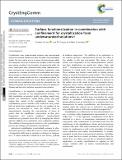| dc.contributor.author | Vartak, Shankul Shisheer | |
| dc.contributor.author | Dwyer, Leia Mary | |
| dc.contributor.author | Myerson, Allan S. | |
| dc.date.accessioned | 2019-02-08T15:43:02Z | |
| dc.date.available | 2019-02-08T15:43:02Z | |
| dc.date.issued | 2018-10 | |
| dc.date.submitted | 2018-09 | |
| dc.identifier.issn | 1466-8033 | |
| dc.identifier.uri | http://hdl.handle.net/1721.1/120286 | |
| dc.description.abstract | Crystallization from undersaturated solutions was demonstrated using functionalized nanoporous silica (Zorbax® chromatographic media). The silica matrix acts as a source of bound groups within the nanopores which act to reduce the solubility within the small pore volume resulting in the formation of nanocrystals within the pores. Experiments were conducted within sealed capillaries which were monitored via X-ray powder diffraction. Experiments were conducted for a number of solutes and concentrations and clearly demonstrated a critical concentration in the undersaturated region below which crystals would not form. Concentrations above this critical concentration would form crystals. Batch experiments confirmed that the crystallization yield could be calculated from the difference between the initial concentration before the addition of Zorbax® and the critical (effective saturation) concentration. | en_US |
| dc.description.sponsorship | United States. Defense Advanced Research Projects Agency (Grant W911NF-16-2-0023) | en_US |
| dc.description.sponsorship | Novartis-MIT Center for Continuous Manufacturing | en_US |
| dc.publisher | Royal Society of Chemistry | en_US |
| dc.relation.isversionof | http://dx.doi.org/10.1039/c8ce01543k | en_US |
| dc.rights | Creative Commons Attribution 3.0 Unported license | en_US |
| dc.rights.uri | http://creativecommons.org/licenses/by/3.0/ | en_US |
| dc.source | Royal Society of Chemistry | en_US |
| dc.title | Surface functionalization in combination with confinement for crystallization from undersaturated solutions | en_US |
| dc.type | Article | en_US |
| dc.identifier.citation | Vartak, Shankul, Leia M. Dwyer, and Allan S. Myerson. “Surface Functionalization in Combination with Confinement for Crystallization from Undersaturated Solutions.” CrystEngComm 20, no. 40 (2018): 6136–6139. © 2018 The Royal Society of Chemistry | en_US |
| dc.contributor.department | Massachusetts Institute of Technology. Department of Chemical Engineering | en_US |
| dc.contributor.mitauthor | Vartak, Shankul Shisheer | |
| dc.contributor.mitauthor | Dwyer, Leia Mary | |
| dc.contributor.mitauthor | Myerson, Allan S. | |
| dc.relation.journal | CrystEngComm | en_US |
| dc.eprint.version | Final published version | en_US |
| dc.type.uri | http://purl.org/eprint/type/JournalArticle | en_US |
| eprint.status | http://purl.org/eprint/status/PeerReviewed | en_US |
| dc.date.updated | 2018-12-06T13:58:39Z | |
| dspace.orderedauthors | Vartak, Shankul; Dwyer, Leia M.; Myerson, Allan S. | en_US |
| dspace.embargo.terms | N | en_US |
| dc.identifier.orcid | https://orcid.org/0000-0001-5125-1051 | |
| dc.identifier.orcid | https://orcid.org/0000-0002-7596-3595 | |
| dc.identifier.orcid | https://orcid.org/0000-0002-7468-8093 | |
| mit.license | PUBLISHER_CC | en_US |
